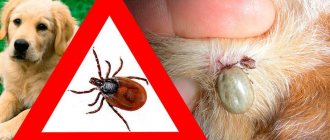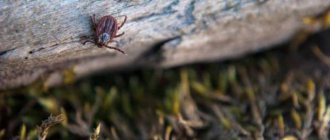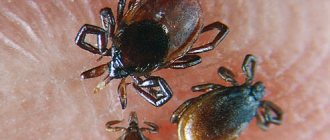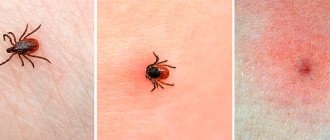Spider mites are an omnivorous pest that affects home plants, garden crops, and even trees. Its presence can be recognized by small light spots on the green parts of the plant and a thin web on the underside of the leaves. You can get rid of spider mites using industrial insecticides or folk remedies.
Spider mites are an omnivorous pest.
Description of the spider mite
It is difficult to see the pest with the naked eye, since its size ranges from 0.2 to 1 mm. Spider mites are herbivorous arthropods that belong to the class of arachnids. Its elongated body is light green, yellow or red, covered with bristles that serve for touch. 8 thin legs end in claws, with the help of which the animal clings to leaves.
Females are larger than males, and their bodies have a more rounded shape. They are capable of laying up to 7 eggs per day, hiding them on the back of the leaves. Future offspring wait out the cold season in cracks in tree bark or fallen leaves. In the egg stage, the pest can survive even in the most severe frosts.
In nature, there are more than 1,300 species of herbivorous web-weaving mites. In Russia, the most common spider mite is the common spider mite, which is polyphagous. The pest is also called strawberry or strawberry pest due to the fact that it is often found on berry crops. It enters a person’s home along with soil, garden tools or particles of earth carried on shoes or clothes.
By sucking out cell sap along with chlorophyll, the mite leaves whitish dots on the leaves.
Numerous spots merge with each other and form large areas of yellow, reddish or brown color. This leads to the leaf drying out and gradually dying. A plant that loses its foliage cannot fully develop and dies.
In addition, constantly moving arthropods spread viruses, gray mold spores and other harmful microorganisms, causing additional damage to the crop.
Description
Spider mites reproduce very quickly and instantly move from one plant to another. Pests feed on the contents of plant cells. The presence of mites can be detected by the appearance of small white dots on the leaves of the plant on the underside of the plate and by the thinnest cobwebs. As a result of the activity of spider mites, some of the plant cells are destroyed, and the intensity of photosynthesis decreases.
With severe damage, the leaves turn white from multiple damages, the plant is enveloped in cobwebs, and a mass of mites accumulates on the tips of the leaves and shoots.
In addition, the mite can infect the plant with incurable viral infections and gray rot spores.
- Wireworm in the garden: how to get rid of it, how to fight it, how to treat it
At home, in the garden and garden, plants are damaged by several types of spider mites:
- common (lat. Tetranychus urticae): the length of female common spider mites can be from 0.4 to 0.6 mm, males are usually shorter - from 0.3 to 0.45 mm. At the larval stage of development, mites are transparent, painted in different colors: from pale green to greenish-brown. Large dark spots are clearly visible on the sides - the blind sacs of the midgut. Tick larvae have 6 legs, and adults have 8 translucent legs with prehensile claws. Spider mites live everywhere except Antarctica. The life cycle of the common tick consists of several stages: egg, larva, nymph and adult, colored red-brown and orange (females), as well as greenish or yellowish (males). The common spider mite is a polyphagous, that is, a polyphagous arthropod;
- red (lat. Tetranychus cinnabarinus). This pest damages agricultural and ornamental plants. In warm regions it lives in open ground, and in northern regions it lives only indoors;
- Atlantic (lat. Tetranychus atlanticus) – a ubiquitous species of mite that damages cucumbers;
- Turkestan (lat. Tetranychus turkestani) is a polyphagous plant that feeds on both garden plants (tomatoes, peppers, cucumbers) and ornamental plants.
Common pests from this family also include red-legged and Savzdarga ticks. However, despite such a variety of pest species, measures to combat spider mites are almost the same.
Which plants and flowers are susceptible to pest attack?
Spider mites feed on plant cell sap. In spring, the first generations colonize garden weeds - quinoa, nettle, coltsfoot, plantain. By mid-summer, pests move to flower and fruit crops.
Strawberries are susceptible to attack by spider mites.
The following plants are at risk:
- strawberry;
- strawberries;
- raspberries;
- grape;
- currant;
- gooseberry;
- Apple tree;
- pear;
- cucumbers;
- tomatoes;
- eggplant;
- pepper;
- beans;
- roses;
- aster.
The animal also parasitizes house flowers, especially indoor roses.
What indoor plants do spider mites love?
The fight against spider mites on flowers will be even more effective if you know which plants the pest likes and which ones it does not like.
Since mites feed on plant sap, sucking it out of leaves, they choose flowers with thin leaves:
- roses;
- dracaenas;
- anthuriums;
- azaleas;
- callas;
- balsams;
- ivies;
- ficus;
- fuchsia.
Harmful insects do not like fragrant plants and flowers with fleshy or hairy leaves:
- color;
- gloxinia;
- tansy;
- calendula;
- parsley;
- aloe;
- mustard;
- chamomile;
- calceolaria;
- Saintpaulia;
- marigold;
- basil;
- yarrow;
- celandine.
By placing a pot with a fragrant plant in a green corner, you will repel pests from your home flowers.
You will be interested to know: Cruciferous flea flea: how to fight and get rid of it using folk remedies
How to remove spider mites from a greenhouse or greenhouse
Ticks love to live in greenhouses because of the comfortable temperature and abundance of greenery. They get there with purchased seedlings or contaminated soil. The favorable microclimate and limited greenhouse space contribute to the rapid proliferation of parasites, which poses a great threat to the future harvest. Therefore, pest control methods are aimed at the speedy destruction and prevention of re-infestation of greenhouse crops: cucumbers, tomatoes, peppers.
The most accessible and easiest method to destroy parasites is to create for them such living conditions under which they would die naturally.
Spider mites cannot tolerate sudden increases in air humidity: moisture levels of 80-90% are fatal for them. The tick's body is physiologically unable to remove excess water from food. With a long-term “water” diet, pests experience a lack of nutrients and stop reproducing. Greenhouse plants, especially cucumbers, on the contrary, love abundant watering.
If you keep the soil well moistened for 5-7 days, most of the pests will die out.
The following measures will help remove the rest of the population:
- Collecting and burning yellowed leaves or dead plants.
- Application of phosphorus fertilizers to the soil.
- Treating the greenhouse frame and plants with homemade products, such as onion and garlic paste.
- Frequent weeding and loosening of the top layer of soil.
- Irradiation with a UV lamp once a week for 2 minutes.
If the available means do not help, they resort to baiting the parasites with industrial insecticides.
In the garden or vegetable garden
On a personal plot, the peak of spider mite activity occurs in July-August. Hot and dry weather contributes to the rapid spread of the pest throughout the entire dacha area.
First, arthropods appear on the first spring weeds - overwintering females lay eggs in nutritious greenery. Therefore, timely weeding and mowing of grass in the garden is a good prevention of further reproduction of ticks.
If a mite is found on strawberries, it is necessary to increase the frequency of watering.
If pests are detected on strawberries, grapes or other crops, the frequency of watering is increased, creating unbearable living conditions for insects. It is advisable to direct a stream of water directly at the plant or bush - this will mechanically remove mites from the foliage. In an open area, it is more difficult to achieve a humidity level above 80% that is harmful to mites, so after watering or spraying the plants, they are covered with film for several hours.
Affected leaves, stems and dead plants are collected and burned to prevent the spread of parasites. Frequent loosening of the soil crust and removal of weeds helps control the mite population. Digging the beds destroys wintering females, so it is advisable to do it annually in the spring and autumn. Adding phosphorus fertilizers to the soil not only has a good effect on the formation of the root system of plants, but also protects them from pests.
If these measures are not enough, they resort to treating plants with industrial insecticidal and acaricidal solutions.
Use of insectoacaricides
Effective destruction of spider mites can only be achieved by alternating chemicals. This is due to this. that during the season there is a change of several generations of pests, therefore, when using only one insectoacaricide, they develop stable immunity to it. To achieve a lasting result, treatment is carried out 4-5 times with an interval of 5-7 days.
Each subsequent spraying is carried out with a pesticide with a different active ingredient. It is impossible to mix chemicals into one “cocktail”, as this will lead to the emergence of a new generation of pests that are resistant to all components of the poisonous agent.
When working with chemicals, you need to take care of your own safety. Spraying is carried out wearing a respirator and protective gloves. After treatment, the face and hands are washed with soap, work clothes are washed, and the work sprayer is washed several times with a soap-soda solution.
Akarin is used to combat spider mites
The following drugs have proven themselves well in the fight against spider mites:
- “Akarin.”
- "Aktellik".
- “Anti-mite.”
- "Apollo".
- "Iskra-Bio".
- “Kleschevit.”
- "Neoron".
- “Omayt 30”, “Omayt 57”.
- "Tiovit Jet".
- “Etisso.”
The drugs are used according to the attached instructions. It is advisable to use those insectoacaricides that contain a special substance that retains the active substances on plants after rain and dew.
Treatment is carried out in dry, windless weather in the morning or evening hours.
The plantings are generously moistened with the working solution, being careful not to get it on the soil.
Fighting spider mites using biological products
Biological means of protecting plantings involve introducing natural enemies to the pests - ladybugs, the predatory phytoseiulus mite, or strains of soil bacteria.
To attract ladybugs to the site, spicy flowers and herbs are planted - calendula, dill, angelica, yarrow, tansy, buckwheat, sweet clover. You can use industrial food for beneficial insects “Wheast”. Ladybugs and their larvae are voracious - they destroy not only herbivorous mites, but also other pests: aphids, whiteflies, scale insects.
The predatory mite phytoseiulus eats adults, larvae, and eggs. It can be purchased in special insectariums - premises for raising beneficial insects. To prevent the appearance of pests, phytosailus is introduced into greenhouses every 14 days in the amount of 5-10 individuals per 1 square meter. m. In case of mass infestation, the number of predators is tripled, and they are populated weekly.
Biotlin is a biological product used to combat spider mites.
Special biological products made using strains and spores of soil bacteria (“Entobacterin”, “Biotlin”, “Fitoverm”, etc.) are also suitable for pest control. These products are safe for humans, animals, birds and beneficial insects. In herbivorous pests, bacterial insecticides cause intestinal toxicosis, leading to their death.
Description and types of ticks
Spider mites on flowers are tiny spiders. The size of its body does not exceed 1 mm. The body is colored brown, gray, brown or green. The color depends entirely on its type. In nature, pests of orange and red colors are found .
It is almost impossible to see a spider with the naked eye. The name cobweb does not always mean that the houseplant will be entangled in cobwebs. A thorough inspection of the plant and assessment of its appearance will help identify the pest that has taken up residence. The spider settles on the inside of a leaf, in the soil of a flower pot, or on unharvested dry leaves.
The pest feeds on the cell sap of flowers. It pierces a plant leaf with its jaws and drinks the juice. The leaves of the flowers are covered with small transparent spots. Over time, the leaf, not receiving nutrition, turns yellow and falls off. As the spider spreads and a large number of individuals appear, the flower dies. Both adults and their larvae feed on plant juices.
The spider mite, contrary to its name, does not always weave a web around indoor plants. Small cobwebs can be seen when the colony is numerous. The spider reproduces quite quickly, with females appearing from fertilized eggs, and males emerging from unfertilized eggs. The spider generation lives no more than a month. During this period, the female manages to lay 150 eggs, which turn into larvae after three days. Spider eggs can lie in the ground for five years.
The spider is able to settle on any plant. It is impossible to meet him except in the Arctic and in the water. The vital activity of the tick occurs actively at above-zero temperatures. A drop in temperature causes the pest to hide and hibernate.
The tick population numbers about 1,200 species. The following pests are most often found in indoor floriculture:
- Common tick. It spreads in the ground and indoors. It settles on the underside of the leaf. It easily crawls from one plant to another. The pest does not tolerate direct sunlight and hides from it.
- Red tick. It is more common and harmful to lemons, roses, balsam and orchids. The body of males is colored red, the body of females is purple.
- The tick is false. It can only be distinguished by its body size. It is smaller and does not grow more than 0.25 mm. It will become noticeable on the plant when there are a million individuals.
- Atlantic tick. It reproduces in high humidity and settles on palm trees and citrus trees. The pest can appear in indoor lemonariums.
- Cyclamen mite. It has microscopic dimensions. It settles on the leaves from the outside, resembling a layer of dust particles. It affects buds , stems and leaf edges of plants. Actively lives and reproduces on tuberous flowers, consumes the juice of cyclamen, balsam and chrysanthemums.
- Broad spider mite. The spider reproduces within five days. It entwines the plant with a web, which hosts a multimillion-dollar colony of red-brown pests. It feeds on the juices of oleander, ficus, cacti and tagetis.
- Flat cactus mite. The pest belongs to the false spider mite. The body is no more than 0.4 mm brick or yellow in color. It affects indoor violets, cacti, some ficus and citrus fruits.
Arachnids are able to adapt to any unfavorable conditions. At low temperatures, they hibernate, beginning their life activity with the onset of warmth and starting to reproduce. The processes of hibernation and stopping the vital activity of the pest are called diapause.
A collection of folk recipes
Folk remedies for spider mites are used at the initial stage of infection or during the fruiting period of crops, when chemicals cannot be used.
The following recipes are most popular among summer residents:
- Soap solution. To prepare the product, 200 g of soap (green, laundry or tar) are grated, diluted in 10 liters of hot water and allowed to cool. The prepared pesticide is generously sprayed onto infected crops once a week, avoiding its contact with the soil. Indoor plants are treated with a sponge dipped in soapy water.
- Infusion of garlic or onion. 30 g of chopped vegetables are poured into 10 liters of boiling water and left in a dark place for 24 hours. An infected garden crop or indoor flower is generously sprayed with the resulting solution several times at intervals of 2-3 days.
- Tobacco decoction. Add 400 g of tobacco or shag to 10 liters of boiling water. The product is boiled over low heat for 20-30 minutes, cooled and left for 24 hours. The finished broth is filtered and diluted with warm water in a ratio of 1:3. Spraying is carried out using a garden sprayer once every 2-3 days.
- Infusion of onion peel. 200 g of onion peels are poured into 10 liters of hot water and placed in a dark place for 1 day. The finished product is filtered and sprayed onto infected crops 1-2 times a week for a month. For indoor plants, wipe the leaves and stems with a decoction.
Affected domestic flowers are isolated from healthy ones. After treatment, the pots with plants are covered with plastic wrap for 2-3 hours, and the trays are scalded with boiling water.
Prevention of occurrence
Preventive measures should be carried out in advance to prevent the development of the first spring generation.
Greenhouses, greenhouses and other summer cottages in which a tick has been spotted must be treated with copper sulfate or fumigated with a sulfur bomb in spring and autumn.
To exterminate wintering females, deep digging of the beds should be carried out 2 times a year, and the infected tops should be burned.
What else needs to be done to prevent ticks from settling in the area:
- Buy seeds treated with pesticides (they cannot be soaked before planting).
- Maintain the distance recommended by the manufacturer between plantings.
- Loosen the earthen crust and remove weeds in a timely manner.
- Plant herbs in the area that attract ladybugs.
- Apply mineral fertilizers on time.
- Follow the rules of crop rotation.
- Regularly inspect the crop for mite infestation.
To prevent ticks, you need to plant herbs that attract ladybugs.
To prevent infection of indoor plants, after purchase, new specimens are kept in quarantine - a separate room - for up to 2-3 weeks. Before spring replanting, soil brought from the site is heated in the oven to kill parasite eggs. In winter, when the air is dry, spray the plants daily with a spray bottle or wipe the leaves with a damp soft cloth.
Prevention of spider mites on indoor plants
Mites love dry air; their larvae can be found in soil or old pots. Indoor plants can become infected from a new flower. Therefore, preventive measures are:
- The new plant should be washed and placed away from home flowers for several days. If no pests are found, the plant can be placed in a suitable place.
- Before transplanting or planting, the soil is disinfected by calcination in the oven. You can hold the soil in a water bath or pour boiling water over it.
- If the air in the room is dry, the home flower is sprayed several times a day. During the winter season, apartments have heating radiators that heat and dry the air. In this case, the air must be humidified. You can use special humidifiers, place containers of water around the flowers, cover the radiators with wet towels, or spray the air around the plants with water at room temperature as often as possible.
- Plants that spider mites do not like will repel insects from flowers. Plant, grow in a pot and place calendula or another plant among the flowers (read the list above).
- To prevent spider mites, you can spray indoor plants with special acaricide preparations from time to time.
You will be interested to know: How to deal with wireworms in the garden in the fall
Under the right growing conditions and care, no pests will settle on indoor plants. But if an infection does occur, the fight against spider mites on flowers should begin as quickly as possible.











